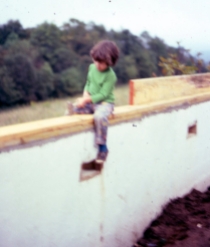(This is the sixth in an eight-part series. If you haven’t been following the journey, you may want to start back at the beginning and work your way forward.)
As idyllic as our wild life can be, we welcome the August arrival of electricity. The electric cooperative has to run power up the mountain to put in our temporary pole. We can only operate one or two items at a time, but that’s a big improvement over hand saws and drills.

We have a road put in, a necessity for getting deliveries of building materials, our water reservoir and septic tank. An added bonus—no more walking in and out with groceries, laundry, and those heavy five-gallon water containers.

Building the road is one of the few things we don’t do ourselves.
Summertime’s a damp season up here, but this year it’s been extreme, raining nearly every day. We need it relatively dry to finish digging these trenches or the walls could fall in. There’s nothing to do but wait—impatiently—for things to dry up.
Out of the blue, we experience David, our first hurricane in the mountains. The Gnome and I lie awake all night listening to the wind blow across the mountains. Each time it does, we hear it roaring through the trees for at least five minutes before it finally reaches us. When it does hit, it hits with a fury, tearing at our plastic walls. They weren’t meant for this kind of abuse. When we’re not making a futile effort at sleep, we’re outside in the driving rain and wind furiously nailing up strips of scrap lumber to try to hold whatever remains of the plastic in place.
At about 5:00 am we’re too exhausted to care much anymore—which is just as well since the plastic roof caves in. The kiddles slept through it all.

After a nightlong battering, our black plastic “roof” caves in, dousing everything.
After the kids leave for school, we buy supplies and put on a real roof with plywood and asphalt rolls. Within days we get reports that a second hurricane is following David’s path. We rush into town for blackboard to replace the plastic walls.
In retrospect, 2017: Well, obviously, we should have invested more into this structure. It would have come in handy later, too, as an outbuilding.
Other than to adhere the first course of concrete block to the footings, we forego the traditional mortar in favor of fiberglass reinforced bonding cement. The snow-white mixture with its shard-like fibers bears a remarkable resemblance to shredded coconut and has us craving for macaroons.
We have to keep our heads covered while we’re mixing so our hair doesn’t bond to our scalps. As usual, we improvise, using old t-shirts as makeshift hats.
Building the foundation has been nervewracking. For all the how-to books on home construction, we’ve been able to find absolutely no guidance on this critical first step. Even the extensive building code offers no direction. We have a great reference book titled From the Ground Up. We wish in vain for a From the Ground Down manual.
In retrospect, 2017: We did okay—the house is still standing.
The kids like to help when they get home from school.
(Stay tuned for Part 7 of Early Days on the Diagonal.).











Pingback: Daily Life: Early Days on the Diagonal, Part 5 – Living on the Diagonal
This was the part I had been waiting for–to see how you actually began the building process. VERY interesting! “Fiberglass reinforce bonding cement” sounds like it would be a challenge to work with!
LikeLiked by 1 person
Leslie, it’s what we were waiting for, too. Seemed to take a long time to get there. Actually, applying Surewall was much easier than using mortar would have been. Kind of fun, actually. We liked making designs in the walls with our trowels.
LikeLike
When I see the beautiful house your labors provided, I cannot imagine all you went through. Love reading your blog.
LikeLiked by 1 person
Thank you, Jan.It made our lives much richer.
LikeLike